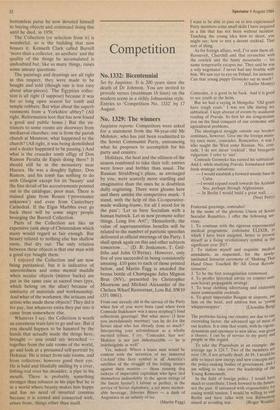Postscript
Aesthete
P. J. Kavanagh
Grey and yellow syenite, green and black diorite, baleful basalt, piebald breccia, alabaster, nummulitic limestone and striped aragonite — the ancient Egyp- tians made small and pleasant vessels out of all these and it is pleasant to reel off their names. The natural stones had to be noticed, appreciated, then hollowed out and shaped and smoothed — and are now in a glass case in the Burrell Collection outside Glasgow.
Not too many of them, about 15, with breathing-space around them and, through the glass wall, trees behind. This part of the fine new building which now houses the Collection, opened last year, was called by the architect a 'walk through the woods' and it is like that; a ceramic Buddha- worshipper peacefully squats, apparently surrounded by full-grown chestnuts and sycamores that also frame a porphyry head of Zeus.
What must it be like to be a 'collector'? Ceramics, tapestries, armour, stained glass, paintings, sculpture, clothes . . . . They are all selected and put into order here but what can it have been like for Sir William Burrell? He must have sometimes been overwhelmed by the mounting, top- pling pile of his possessions.
Born into a Glasgow shipping family in 1861 he made money by selling his fleet when times were booming, rebuilding it cheaply during a slump, and when times looked up he could undercut everybody else. In 1916 he sold it finally for four times what it had cost him and after it had already paid for itself. With a nearly
bottomless purse he now devoted himself to buying objects and continued doing this until he died, in 1958.
The Collection (or selection from it) is wonderful, so is the building that now houses it. Kenneth Clark called Burrell 'more than a collector, an aesthete' and the quality of •the things he accumulated is undoubted but, like so many things, raises some uneasy questions.
The paintings and drawings are all right in this respect, they were made to be bought and sold (though one is less easy about altar-pieces). The Egyptian collec- tion is all right (I suppose) because it was for so long open season for tomb and temple robbers. But what about the superb vestments from a Yorkshire abbey? (All right, Reformation loot that has now found a good and public home.) But the en- trances to some rooms are doorways from mediaeval churches; one is from the parish church at Montron; what happened to the church? (All right, it was being demolished and a dealer happened to be passing.) And what is the crusader tomb effigy of Don Ramon Peralta de Espes doing there? It should still be in the monastery near Huesca. He was a doughty fighter, Don Ramon, and his tomb has nothing to do with Glasgow except for its 'beauty' and the fine detail of his accoutrements pointed out in the catalogue, poor man. There is stained glass from Rouen ('provenance unknown') and even from Canterbury Cathedral. If the Elgin Marbles ever go back there will be some angry people besieging the Burrell Collection.
Parts of the Collection are like an expensive junk shop of Christendom which many would regard as fair enough. But beauty related to nothing else has shallow roots, that dry out. The only relation between these objects is that one man with a good eye bought them.
I enjoyed the Collection and am now being puritanical, but it is indicative of unrootedness and some mental muddle when secular objects (mirror backs) are put in the same case as sacred ones (pyx, which belong on the altar) because of similarity of materials and workmanship. And what of the workmen, the artisans and artists who made these objects? They did it for pay, but whatever extra they put into it came from somewhere else.
Whatever I say, the Collection is worth an enormous train fare to go and see. But if you should happen to be haunted by the hands that actually made the things here, brought — you could say wrenched together from the sale rooms of the world, go and look at a presumed self-portrait by Hokusai. He is intact from sale rooms, and from collectors, however good their eye. He is bald and blissfully smiling by a river, fishing-rod over his shoulder, a pipe in his mouth. There is probably something stronger than tobacco in his pipe but he is in a world where beauty makes him happy and has no need of inverted commas because it is rooted and connected with, arises from, things other than itself.







































 Previous page
Previous page